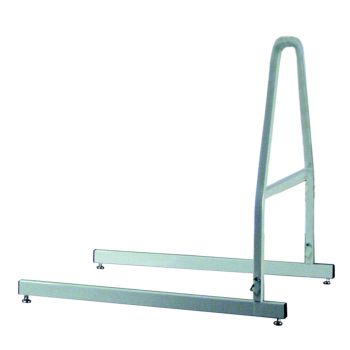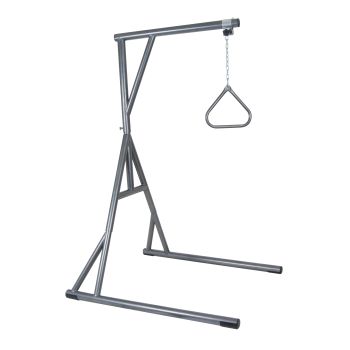Free shipping orders over $50
Bed Trapeze / Medical Trapeze
Whether you need help with sitting up in bed or transferring in and out of bed, a bed trapeze may be your key to independent mobility while in bed as well as while you get in and out of bed. A medical trapeze hangs over the bed to function as a grab bar, providing leverage for patients with upper body strength to position themselves without help. Read More...
-
Economy Trapeze
Starting at $33.86 -
Invacare Trapeze
Starting at $218.40 -
Lumex Trapeze Floor Stand
Starting at $166.74 -
Versa-Helper Trapeze
Starting at $126.00 -
Bariatric Trapeze Bar
$1,307.01 -
Standard Trapeze Bar
Starting at $33.86 -
Bariatric Floor Stand w/ Trapeze
$3,793.41 -
Heavy Duty Trapeze with Base and Wheels
$1,559.00
How to Choose a Hospital Bed Trapeze
If you are unfamiliar with bed trapezes and their functions, it may be overwhelming to try and decide which trapeze is best for your needs. With some basic information and a few simple guidelines, you can be more confident that you are making the correct purchase.
What is a Bed Trapeze?
The standard medical trapeze bar is a mobility assistive device which is a very sturdy triangle trapeze that is attached to an overhead metal frame. The trapeze hook is positioned to be suspended over the bed and is either anchored to the hospital bed frame or connected to a stand-alone base with long legs that extend under the bed. This mobility aid is indicated for use by patients who are confined to bed for long periods of time, or have limited lower body mobility and use a wheelchair to get around.
Bed Trapeze Types
1. Floor Trapeze
A bed trapeze floor stand model can generally handle heavier weights than other trapeze types. For this reason, many if not all bariatric trapeze models are equipped with a floor stand. This trapeze style is freestanding, with a base that sits on the floor. Some are equipped with wheels for easier maneuvering. Before purchasing a floor trapeze, check the clearance under the bed; a platform bed will not be compatible to such a product.
2. Bed Trapeze
Another option is a bed mounted trapeze, which is less cumbersome and can be attached directly to the bed to save space and stay out of the way. These overhead trapezes are often only compatible with hospital beds or beds with a metal frame. You can also choose a bed trapeze that mounts on the ceiling over the bed, or on the adjacent wall. Remember to check the compatibility of the trapeze you are considering to ensure that it will work with the bed you have.
3. Combination Models
In the case of some products, you may have the option to choose to purchase the trapeze bar on its own or together with a compatible floor stand. These products can alternatively be attached to the bed frame or stand alone with the help of the base.
Bed Trapeze Weight Capacity
When buying a hospital bed trapeze, consider your options carefully. A trapeze bar must be able to support the full weight of the user.
When choosing a trapeze bar for bed mobility, be sure to check the weight capacity of the item and confirm that it can handle the patient’s weight. When necessary, consider a bariatric model that can offer reliable support even for heavier patients.
How to Use a Hospital Bed Trapeze
Once you have chosen the ideal product for your needs, it is important that you understand the uses of the bed trapeze you are purchasing. By familiarizing yourself with appropriate medical trapeze use, you position yourself (excuse the pun!) to enjoy the full benefits of your assistive device.
What are the Uses of a Bed Trapeze?
The following are some of the important functions a medical trapeze serves and the ways they can benefit users:
- Re-positioning Assistance: By grasping the base of the triangular hook, patients can safely and independently shift themselves in bed to (1) find a more comfortable position, (2) prevent injury and reduce caregiver strain while providing patient care and (3) performing regular position changes, which is imperative for avoiding bed sores.
- Transfer Assistance: Getting in and out of bed, especially one that is higher than the seat of a wheelchair, can present a real challenge for some individuals. With an overhead hospital trapeze, users have the necessary leverage to lift themselves into and out of bed using their own upper body strength and relying on the sturdy support of the strong handlebar and frame.
- Muscle Strengthening: When a patient relies on a trapeze bar for transferring and positioning assistance, they benefit from the side advantage of stretching and strengthening all major muscle groups. This is particularly helpful for bedridden patients who otherwise have very limited opportunities to exercise. Even when position changes aren’t necessary, trapeze bars are often used as exercise equipment for torso, arms and upper body physical therapy and/or rehabilitation.
- Increased Independence: All of the above uses facilitate increased patient independence and may restore a user’s confidence and dignity by allowing them to accomplish more on their own.
Setting up a Trapeze Bar
Trapeze bars generally feature tool-free assembly and can be done easily by a caregiver, following the user’s manual.
The overall height of the trapeze frame can usually be adjusted to allow the hook to hang in the most comfortable place for the user. In addition, the trapeze handle can often be slid sideways to adjust the vertical positioning. In this way, caregivers can ensure maximum comfort and efficiency.
Caregiver Usage Instructions
Medical trapeze bars are indicated for patients who have (1) upper body strength and (2) extremity usage, and are (3) cooperative and (4) able to follow instruction.
While overhead trapeze bars can significantly reduce the effort required by the caregiver, it is important that patients are always supervised during position changes unless the patient is known to be able to handle repositioning safely and independently.
In some cases, patients may require some assistance in using a trapeze bar. In such events, always be sure to lock hospital bed wheels in place to prevent injury to the caregiver and patient. In addition, have the bedrails lowered and the bed adjusted to the caregiver’s waist height.
All of our trapeze bars for hospital beds and home use qualify for fast, free shipping so place your order today and we’ll have it shipped for you by tomorrow!











